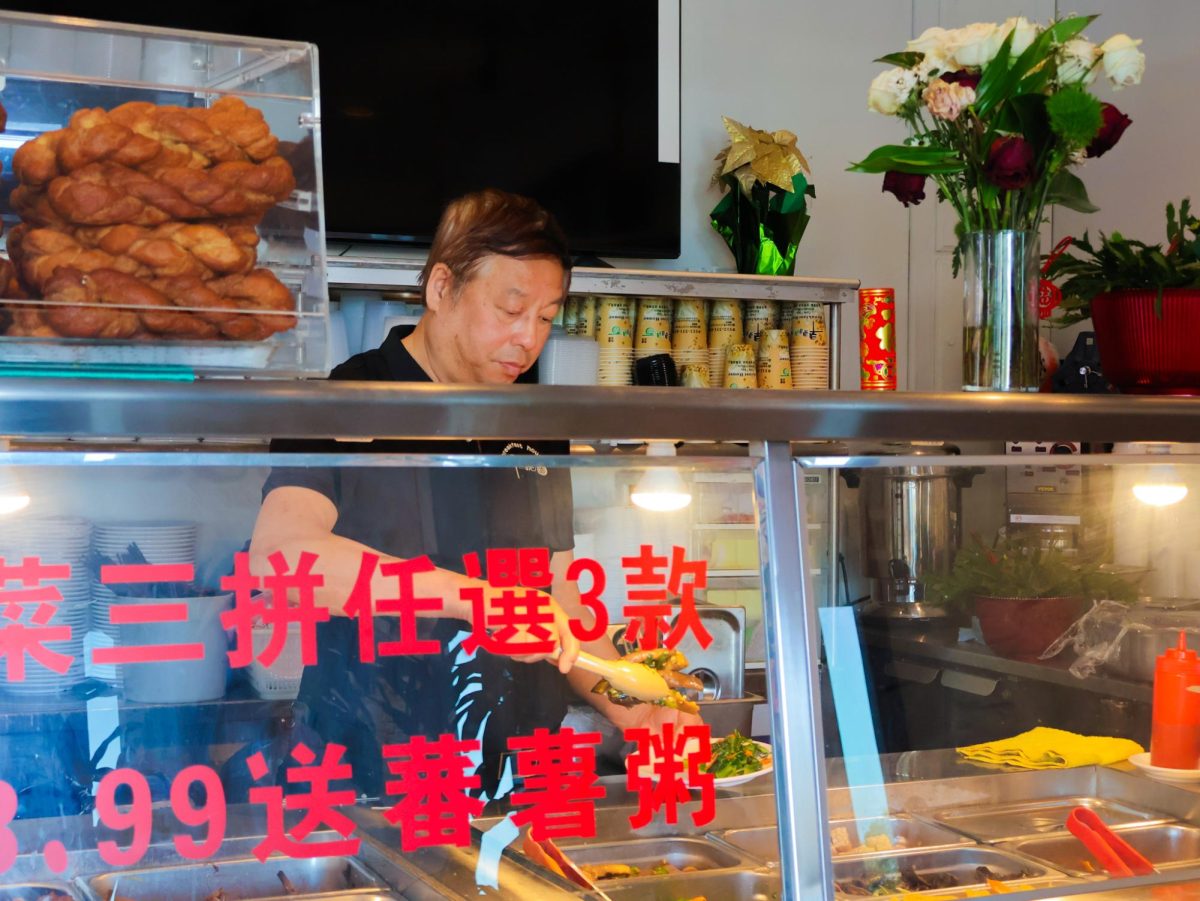Behind glass windows and red Mandarin characters, behind an assortment of Chinese cold dishes, garlicky cucumbers, spicy pig ear, sliced celtuce, tubs of porridge, and silken tofu, Mr. Carey Shao runs the Breakfast House, or “zao dian jian mian” in Mandarin. Stepping into their store opening, customers can sit at one of several dark marble tables and scan a QR code to order in one of two languages, English or Mandarin, making the restaurant accessible to all customers regardless of background. The store’s proximity to a nearby daycare brings in a lot of families with young children, sending laughter and squeals of excitement throughout the establishment.
Breakfast House currently serves as Austin’s only Chinese restaurant catering primarily to northeastern Chinese tastes, boasting a wide and ever-changing menu with fresh, authentic dishes. Mr. Shao and Breakfast House arrived in Austin in the fall of last year from a community on the outskirts of San Jose, California. There, he first served a wide variety of northeastern Chinese-style dishes, as well as Taiwanese specialties, including beef noodle soup and bubble tea.
“I ran a restaurant business for 20 years. We’d already retired but had nothing to do, so we decided to reopen our business. We had friends in Austin that invited us to come over here,” Mr. Shao said.
After researching Austin’s demographics, Mr. Shao noticed a lack of northeastern Chinese food in the area, and a particular absence of Chinese breakfast places. In particular, amongst a myriad of family-owned Chinese restaurants or franchises, most spots focus strictly on heavier, noodle-based dishes or spicy eats from southern China, such as Szechuan or Hunan.
“It’s very rare to find Chinese breakfast places, and one that is specialized like ours is even more rare,” Mr. Shao said. “[At Breakfast House], the food is based on typical Chinese tastes. Even though Chinese food has regional differences, there are commonalities such as a taste for soybean milk or Chinese donuts (youtiao), green onion pies, and wontons. People from other countries also like those foods.”
The myriad of foods Breakfast House serves is also represented by their store name — in Mandarin, “zao dian” can mean ‘breakfast’ or ‘sooner’, and “jian mian” means ‘meet’.
“‘Zao dian’ refers to the specialty food that we serve, so ‘zao dian jian mian’ has a double meaning: we hope the specialized breakfast can meet our guests early,” Mr. Shao said.
Since Breakfast House’s opening, the establishment has also expanded their repertoire of dishes past breakfast food, venturing into specific regional lunch and stir-fry dinner dishes as well as a variety of cold side dishes, incorporating traditional Chinese flavors such as mala and regional specialties like Sichuan pig ear salad.
“The [stir-fry] dishes are mostly common household dishes. I [try to pay] attention to what customers like, trying to accommodate the tastes and needs of both northern and southern parts of China, including Taiwanese tastes,” Mr. Shao said. “We frequently refresh the cold dishes, which are made daily, so it’s always fresh for the customers.”
Mr. Shao strives to keep the menu fresh and unique for customers. In addition to a variety of Breakfast House staples, the restaurant changes their menu from time to time: one week, a customer might find Dongbei Guo Bao Rou, a sweet and sour breaded pork popular among children; another week, one may arrive to find the sour and comforting Suan Cai Bai Rou, a dish of thin, chewy glass noodles topped with pickled mustard greens and meat. Above all, Mr. Shao works hard to ensure each dish is as fresh and authentic as possible.
“[Because of the relatively small Chinese population here,] I noticed a lot of other restaurants hire mostly non-Chinese chefs. In order to ensure our food is authentic Chinese, I pay higher salaries for experienced Chinese chefs,” Mr. Shao said.
Recently, among dipping consumer confidence in the country, Mr. Shao and the restaurant have had to grapple with increasing prices and the uncertainty of various inputs, such as the non-native celtuce from local Asian grocers or the proper cuts of meat for specialty cold dishes. In the face of these complications, Breakfast House’s business model works to its favor.
“We have [economic] difficulties, but we face the challenge of the market prices and we remain flexible. In Austin, as far as I know, no other restaurants provide [our variety of foods],” Mr. Shao said.
The restaurant’s online menu primarily helps adapt to the hardships of the business, as it is easier to grapple with changing prices and items on a digital platform. The online menu also particularly helps Mr. Shao interact with customers given his limited English proficiency.
“My English is not ideal. A lot of times, I need to ask for help from others. It can be hard to find the right people to help,” Mr. Shao said.
Ultimately, to Mr. Shao, such struggles are part of the price to pay for running a fulfilling business.
“We hope the community here can enjoy a good variety of authentic Chinese food from us. That’s the goal at the end of the day,” Mr. Shao said.




















